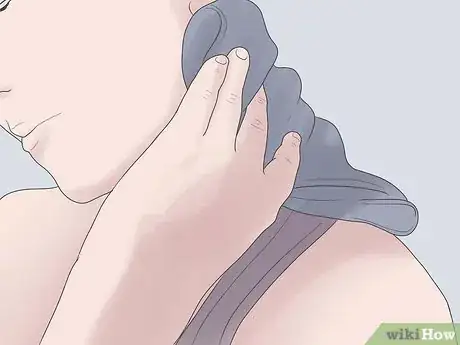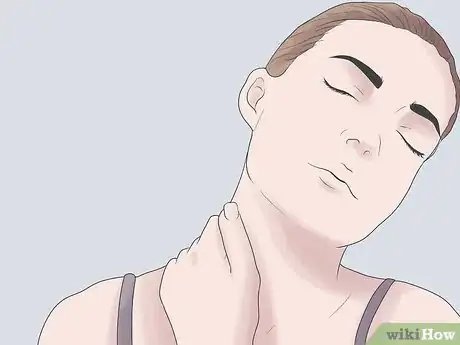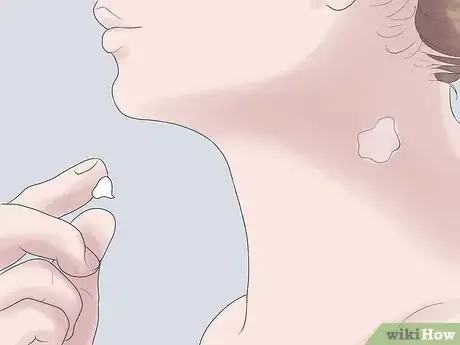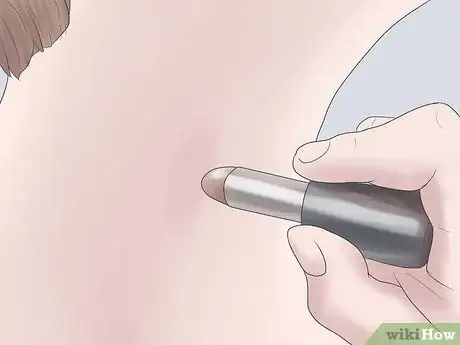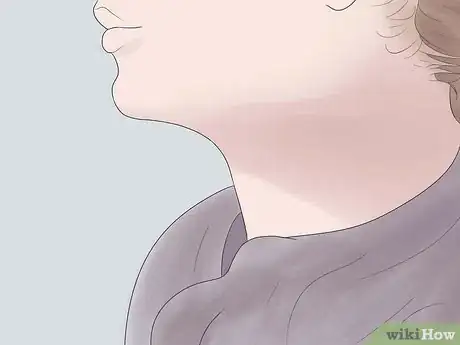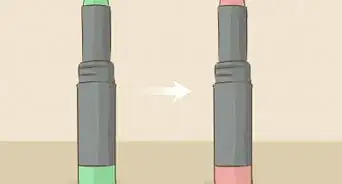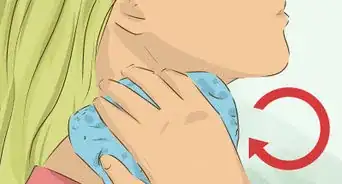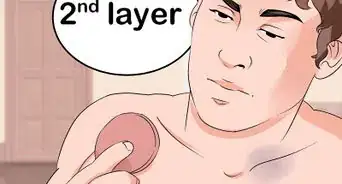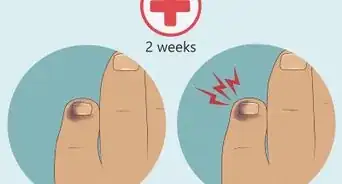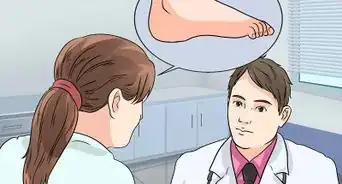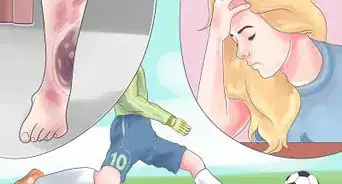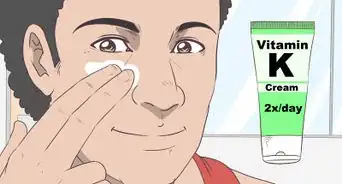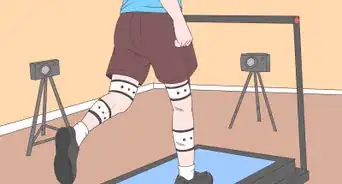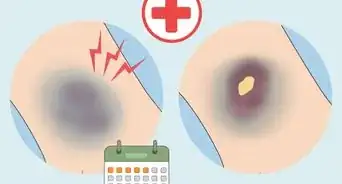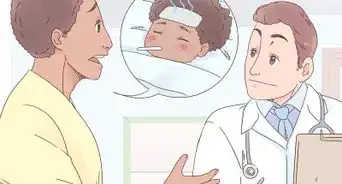This article was co-authored by Alicia Ramos. Alicia Ramos is a licensed aesthetician and the owner of Smoothe Denver in Denver, Colorado. She received her license at the School of Botanical & Medical Aesthetics, with training in lashes, dermaplaning, waxing, microdermabrasion, and chemical peels, and now provides skin care solutions to hundreds of clients.
This article has been viewed 186,655 times.
A hickey is essentially a bruise created by sucking or biting the skin until the blood vessels below the skin break. Although this highly-recognizable “love bite” may not cause any pain, it can be embarrassing and difficult to conceal. Like most bruises, hickeys take between one to two weeks to heal, but if you treat the wound quickly it may speed up the healing process. Knowing how to treat the bruise and cover up its traces can help you feel more confident and look your best.
Steps
Treating the Hickey for the First 48 Hours
-
1Choose a cold compress. You can use ice or a cold compress, but be sure to wrap it in a towel.[1] Or, put a metal spoon in the freezer, and apply the back side of the spoon directly to the site of the hickey.
-
2Apply cold compress to the hickey. Cold helps bruises by reducing swelling and slowing blood circulation.[2] Apply the cold compress for 10 to 20 minutes at a time, several times each day.Advertisement
-
3Prevent further trauma. Certain activities can cause bruises (including hickies) to swell, which may prolong the healing process. For the first 48 hours after you've gotten a hickey, avoid "traumatic" activities, including:
- hot showers
- hot tubs
- heat packs
- drinking alcoholic beverages
Caring for the Hickey After 48 Hours
-
1Switch to a warm compress. Ice is only really effective for the first 48 hours.[5] After icing the hickey for 48 hours, you'll want to switch to a warm compress for the remainder of your treatment regimen.
- Ice heals the broken blood vessels, but heat will help increase blood flow to the area. This will facilitate healing and the reabsorption of blood.[6]
- Use a hot water bottle or a microwavable heating pad.[7]
- Do not apply heat therapy for longer than 20 minutes at a time. Don't use heat therapy if you have diabetes or poor circulation.[8]
-
2Massage the bruise. In addition to applying a warm compress, massaging a bruise like a hickey can help facilitate blood flow to the site of the injury.[9] Common methods of massaging a hickey include rubbing it with your hands or applying pressure using:
-
3Treat the skin. Icing, heating, and massaging the skin will all help the bruise heal, but you may want to treat the skin in order to make the physical mark disappear more quickly. No skin treatment will provide instant results, but will help speed up the healing process.[13] Common skin treatments include:
Covering Up a Hickey
-
1Wear your hair down. If you have long hair, you can simply wear your hair down to cover up hickies on your neck and shoulders.[21] Not everyone will have hair long enough to conceal a hickey. Fortunately, if you do not have long hair, there are still plenty of options to cover up your hickey.
-
2Apply makeup. While the bruise from a hickey heals, you may want to cover it up so that it is less visible. Try using concealer, foundation, and/or powder to mask the hickey.[22]
-
3Hide the hickey. Depending on how you typically dress and what time of year it is, there are many ways you can quickly and easily hide your hickey. The key is hiding the hickey in a way that won't draw attention to it. Try concealing the bruise by wearing:
Warnings
- Don’t take aspirin to treat a hickey. This medication can thin the blood and make you bleed more easily. Although hickeys rarely require pain relief, you can take Tylenol or ibuprofen for pain without interrupting your bruise from healing.⧼thumbs_response⧽
Things You'll Need
- Ice
- Paper towel
- Spoon
- Toothbrush
- Arnica gel
- Witch hazel
- Concealer
- Scarf/accessory
References
- ↑ http://www.drweil.com/drw/u/ART02931/Bruises.html
- ↑ https://www.urmc.rochester.edu/encyclopedia/content.aspx?ContentTypeID=1&ContentID=4483
- ↑ https://www.urmc.rochester.edu/encyclopedia/content.aspx?ContentTypeID=1&ContentID=4483
- ↑ https://www.urmc.rochester.edu/encyclopedia/content.aspx?ContentTypeID=1&ContentID=4483
- ↑ https://www.urmc.rochester.edu/encyclopedia/content.aspx?ContentTypeID=1&ContentID=4483
- ↑ https://sexinfoonline.com/the-pros-and-cons-of-a-hickey/
- ↑ https://www.urmc.rochester.edu/encyclopedia/content.aspx?ContentTypeID=1&ContentID=4483
- ↑ https://www.urmc.rochester.edu/encyclopedia/content.aspx?ContentTypeID=1&ContentID=4483
- ↑ https://sexinfoonline.com/the-pros-and-cons-of-a-hickey/
- ↑ https://sexinfoonline.com/the-pros-and-cons-of-a-hickey/
- ↑ https://sexinfoonline.com/the-pros-and-cons-of-a-hickey/
- ↑ https://sexinfoonline.com/the-pros-and-cons-of-a-hickey/
- ↑ https://sexinfoonline.com/the-pros-and-cons-of-a-hickey/
- ↑ https://sexinfoonline.com/the-pros-and-cons-of-a-hickey/
- ↑ https://sexinfoonline.com/the-pros-and-cons-of-a-hickey/
- ↑ https://sexinfoonline.com/the-pros-and-cons-of-a-hickey/
- ↑ https://sexinfoonline.com/the-pros-and-cons-of-a-hickey/
- ↑ Alicia Ramos. Skincare Professional. Expert Interview. 12 June 2019.
- ↑ http://www.drweil.com/drw/u/ART02931/Bruises.html
- ↑ http://www.drweil.com/drw/u/ART02931/Bruises.html
- ↑ https://sexinfoonline.com/the-pros-and-cons-of-a-hickey/
- ↑ https://sexinfoonline.com/the-pros-and-cons-of-a-hickey/
- ↑ https://sexinfoonline.com/the-pros-and-cons-of-a-hickey/
- ↑ http://timesofindia.indiatimes.com/life-style/beauty/How-to-get-rid-of-love-bites/articleshow/33442678.cms
- ↑ https://sexinfoonline.com/the-pros-and-cons-of-a-hickey/
- ↑ https://sexinfoonline.com/the-pros-and-cons-of-a-hickey/
- ↑ https://sexinfoonline.com/the-pros-and-cons-of-a-hickey/
- ↑ https://sexinfoonline.com/the-pros-and-cons-of-a-hickey/
- ↑ https://sexinfoonline.com/the-pros-and-cons-of-a-hickey/
- ↑ https://sexinfoonline.com/the-pros-and-cons-of-a-hickey/
About This Article
If it’s the first 48 hours after you’ve gotten a hickey, try getting rid of it by applying ice or a cold compress to the area for 10 to 20 minutes at a time, several times a day. Doing this can help heal the broken blood vessels that cause the bruising. Since ice is really only effective if applied within the first 48 hours, switch to using a warm compress like a hot water bottle for 20 minutes at a time if you’ve had the hickey for longer. Along with the warm compress, you can massage the hickey to help blood flow to the area. While it won’t give you instant results, you can speed up the healing process by applying a skin treatment like aloe vera or taking a vitamin C, E, or K supplement. For more tips, including how to cover up a hickey, read on!

